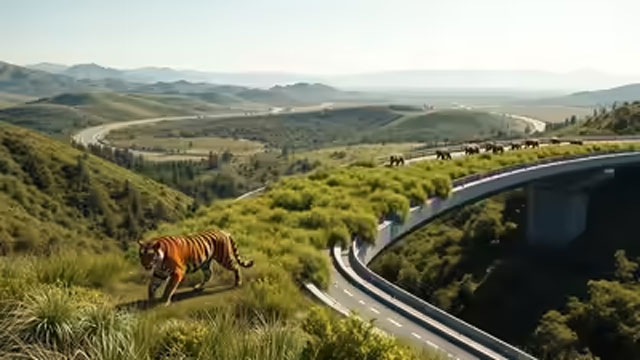Daijiworld Media Network- New Delhi
New Delhi, Jul 22: In a groundbreaking move that blends modern infrastructure with ecological responsibility, the National Highways Authority of India (NHAI) has completed the country’s longest and most advanced wildlife corridor on the Delhi-Mumbai Expressway. Spanning a 12-kilometre stretch through the buffer zone of the Ranthambore Tiger Reserve, the corridor features a combination of wildlife overpasses and an underpass, marking a first-of-its-kind achievement in India’s highway development history.
The corridor, located strategically between Ranthambore and the Chambal Valley—both biodiversity-rich zones—is designed to ensure the uninterrupted and safe movement of wildlife such as tigers, sloth bears, antelopes, and more. It includes five dedicated overpasses, each 500 meters long, and a 1.2-kilometre-long underpass, making it the longest continuous wildlife passage ever constructed in the country.

“This 12-km section was among the most technically and environmentally challenging parts of the entire expressway,” said Pradeep Attri, Regional Officer, NHAI. “It passes through sensitive wildlife habitats, so we worked closely with the Wildlife Institute of India and the Ministry of Environment and Forests to ensure minimal disruption to flora and fauna.”
To maintain the natural landscape, parts of the expressway have been constructed in sunken or elevated formats, while 4-metre-high boundary walls have been erected to prevent animals from straying onto the road. Additionally, 2-metre sound barriers help curb vehicular noise, offering a quieter and less stressful environment for wildlife.
“The beauty of this project is that while standing on the surface, you barely notice the highway underneath. This entire zone was built for animals, not humans,” Attri emphasized. Notably, no wildlife accidents occurred during the corridor’s construction, thanks to round-the-clock monitoring and a dedicated safety protocol involving patrol workers every 200 meters.
Adding to its green credentials, the project also saw the planting of over 35,000 trees, installation of rainwater harvesting systems at 500-m intervals, and the use of drip irrigation to significantly reduce water usage. Eco-friendly modular construction methods were used to minimize material waste and reduce the project's carbon footprint.
Wildlife camera traps have already captured several sightings of tigers and bears using the corridor, reaffirming its early success. This initiative has now set a new benchmark in sustainable infrastructure development, showing the world that India’s highways can progress hand in hand with biodiversity conservation.
The corridor is being hailed as a model for future expressway projects, promoting harmony between human development and environmental preservation.